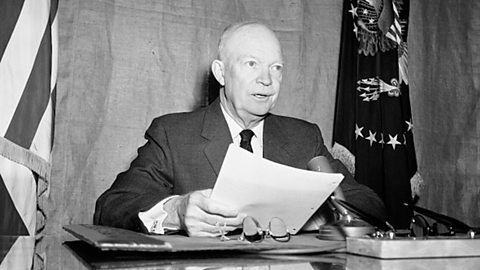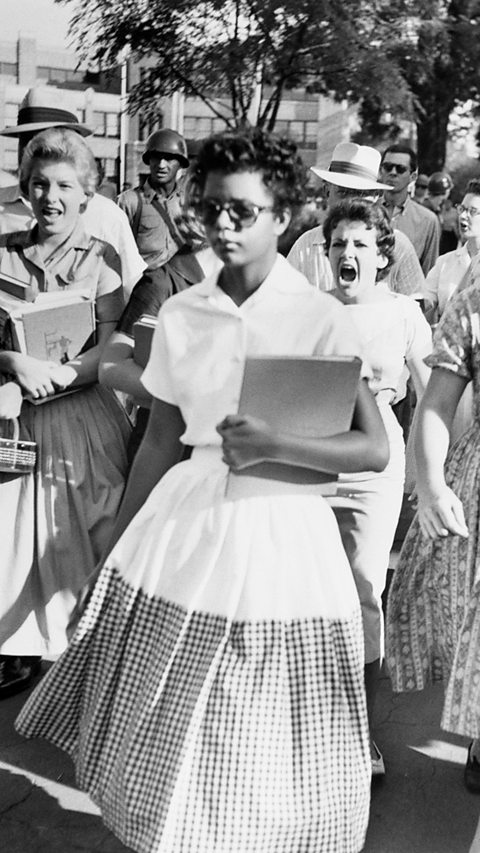The government, official institutions and civil rights in the 1950s
The efforts of the boycotters in Montgomery, Alabama, and the growing influence of campaigners such as Martin Luther King and Rosa Parks increased the profile of the fight for civil rights. There was growing pressure on President Eisenhower and the government to use their power to make changes for African Americans.
President Eisenhowerâs support for civil rights

Eisenhower was respected by the American public due to his position as a general in World War Two but had little political experience when he was elected president in 1953. During a speech to the nation in 1956, Eisenhower made it clear that he wanted to put an end racism and segregationThis meant that white people and black people had to live separately. The areas of society affected by segregation included churches, hospitals, theatres and schools. Over the following three years, Eisenhowerâs government passed the 1957 Civil Rights Act. They also made efforts to enforce desegregationRemoval of laws that separate people from different races in public places and day-to-day life. in schools as the US Supreme CourtThe ultimate court of appeal in the USA. It makes the final decision on whether a law is permitted by the US Constitution. had directed in Brown v Board of Education of Topeka.
We must strive to have every person judged and measured by what he is, rather than by his colour, race or religion.
Little Rock High School
Events at Little Rock Central High School in Arkansas convinced Eisenhower to take a more active role in supporting school integration.
Nine black American children tried to attend Central High School in Little Rock, Arkansas, in 1957. This was part of a campaign organised by Daisy Bates, president of the Arkansas branch of the National Association for the Advancement of Colored People NAACPThe National Association for the Advancement of Colored People was created in 1909 to eliminate race-based discrimination across the United States of America. Before this, the school had only been attended by white Americans. governorA person who is elected to lead a stateâs government in the USA. Orval Faubus ordered state troopersArmed forces controlled by the governor of a state. to stop the nine students from attending the school, saying that he was doing this for their own safety.

When the Little Rock Nine turned up for school, they were faced by an angry crowd of white Americans and state troopers trying to stop them. The children were escorted home by the police in full view of the worldâs media. A photograph was taken of 15-year-old Elizabeth Eckford being shouted at by a mob of angry people as she tried to pass through them to get to the school. This became one of the defining images of the civil rights campaign.
President Eisenhower tried to persuade Governor Faubus to back down. After riots escalated outside the school, Eisenhower sent in 1,200 federal troopsArmed forces controlled by the president in Washington, DC. to protect the children. They were finally able to attend the school. The troops stayed throughout the year, but the Little Rock Nine still faced abuse inside and outside the school. Minnijean Brown, one of the Little Rock Nine, was expelled for reacting to the abuse she received.
In 1958, Governor Faubus shut all schools in Arkansas to avoid having to desegregate them. The Supreme Court ordered him to reopen and desegregate all schools in Arkansas, but this did not begin until 1961. Schools in the state were not fully integrated until the 1970s.
This was significant because it was the first time a president had intervened in the desegregation of schools. The events also showed that the president and Supreme Court could overrule civil rights decisions made by states. Using the media to embarrass the government into action became an important element of future civil rights protests.
The 1957 Civil Rights Act
In 1957, Eisenhower introduced a billA proposed new law. When a bill is approved by Congress and the president, it becomes an act and is now the law. to improve the rights of African Americans, in particular their ability to vote. The bill faced significant pressure from politicians in the South, which meant that the finalised version of the Civil Rights Act was not as radical as Eisenhower had originally planned. This ultimately restricted the powers of the federal governmentThe central government in the USA, including the president, Congress and the Supreme Court. to enforce the law.
The act set up a commission to investigate how some states prevented black Americans from voting and gave courts the power to prosecute states if they allowed voting discriminationTo treat someone differently or unfairly because they belong to a particular group. However, juries in the South would find states not guilty when they were taken to court.
Due to the lack of change the act brought, the increase in the number of African Americans who registered to vote was less than 5 per cent. However, Eisenhower had brought in the first law that supported African Americans since the 1870s. He also brought civil rights campaigners into the White House, giving the NAACP and Martin Luther King even more publicity.
The formation of the Southern Christian Leadership Conference (SCLC)
Martin Luther Kingâs success at Montgomery and his coordination with President Eisenhower showed that the Civil rights movementAn organised set of activities that brought about a change in the treatment of people from different races in American society. could make a positive change for black Americans.
In 1957, King created the Southern Christian Leadership ConferenceSCLCSouthern Christian Leadership Conference. A civil rights organisation set up in 1957 based on Christian values that peacefully campaigned against segregation in the USA. to organise non-violent resistance across the South. The SCLC worked with a range of civil rights organisations across the South, such as the Montgomery Improvement AssociationMIAThe Montgomery Improvement Association was founded to organise the 1955 bus boycott. to coordinate their efforts to increase awareness and pressure on government.
The SCLC also trained their affiliated groups on how to successfully protest with non-violent methods, as seen in the Montgomery Bus Boycott. By supporting non-violent protest and working closely with churches, the SCLC hoped to attract support from white Americans.
More guides on this topic
- Anti-Communism c.1945-1954 - OCR A
- African Americans c.1945-1954 - OCR A
- Broadening of the campaigns for civil rights - Race - OCR A
- Broadening of the campaigns for civil rights - Women's rights - OCR A
- Broadening of the campaigns for civil rights - Gay rights - OCR A
- Politics and protest - OCR A
- Social problems and attempts to tackle them - OCR A